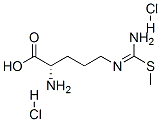S-MTC dihydrochloride (S-methyl-L-thiocitrulline) is a selective neuronal NOS-inhibitor. Following pretreatment with S-MTC dihydrochloride (i.c.v.), the HBO2-induced antinociception is significantly antagonized. In Experiment #2, different groups of mice are pretreated with naltrexone hydrochloride (NTX) (3.0 mg/kg, i.p.), L-NAME (1.0 μg/mouse, i.c.v.), S-MTC dihydrochloride (1.0 μg/mouse, i.c.v.) or N5-(1-iminoethyl)-L-ornithine (L-NIO) (3.0 mg/kg, s.c.) 15-30 min prior to HBO2 treatment. The antinociceptive effect assessed 90 min after HBO2 treatment is completely abolished by NTX and L-NAME, antagonized by two-thirds by S-MTC dihydrochloride and largely unaffected by L-NIO (F=25.57, p<0.0001)[2]. At a dose of 0.3 mg/kg, S-MTC dihydrochloride (SMTC) causes a rise in mean blood pressure (BP). At doses of 1.0, 3.0 and 10 mg/kg, S-MTC dihydrochloride causes falls in heart rate, rises in BP and vasoconstriction in all three vascular beds[3].
